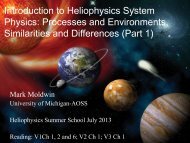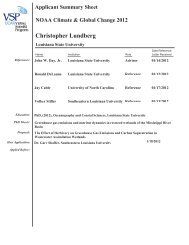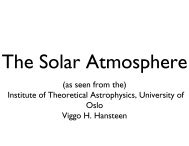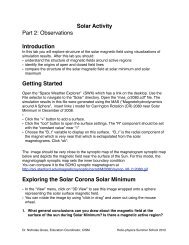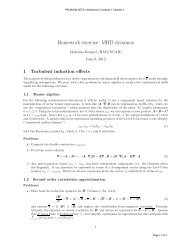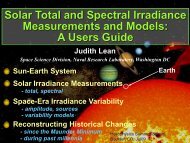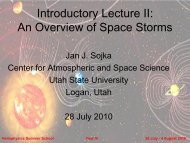Climate Models of Earth and Planets
Climate Models of Earth and Planets
Climate Models of Earth and Planets
Create successful ePaper yourself
Turn your PDF publications into a flip-book with our unique Google optimized e-Paper software.
Boulder July 29, 2008 1Heliophysics Summer School 2009:<strong>Climate</strong> <strong>Models</strong> <strong>of</strong> <strong>Earth</strong> <strong>and</strong> <strong>Planets</strong>
<strong>Climate</strong> <strong>Models</strong> <strong>of</strong> <strong>Earth</strong> <strong>and</strong> <strong>Planets</strong>Caspar M. AmmannNational Center for Atmospheric Research, <strong>Climate</strong> <strong>and</strong> Global Dynamics Divisionammann@ucar.eduHeliophysics Summer School 2009:Boulder July 29, 2008 2<strong>Climate</strong> <strong>Models</strong> <strong>of</strong> <strong>Earth</strong> <strong>and</strong> <strong>Planets</strong>
“<strong>Climate</strong> <strong>Models</strong>” in the news this week:First Cargo-ship scheduled to crossthe Arctic Ocean to save 8000 miles…Forecast <strong>of</strong> development<strong>of</strong> El Nino by NHem WinterBoulder July 29, 2008Heliophysics Summer School 2009:<strong>Climate</strong> <strong>Models</strong> <strong>of</strong> <strong>Earth</strong> <strong>and</strong> <strong>Planets</strong>3
Overview• Introduction <strong>Climate</strong> System– <strong>Climate</strong> : A forced, damped oscillator• Range <strong>of</strong> <strong>Climate</strong> <strong>Models</strong>– Key physical laws that govern climate– Feedbacks– General Circulation <strong>Models</strong>, comprehensive <strong>Earth</strong> System <strong>Models</strong>• Current State <strong>of</strong> the Art– <strong>Climate</strong> Change– Solar Variability <strong>and</strong> <strong>Climate</strong> <strong>Models</strong>• SummaryBoulder July 29, 2008Heliophysics Summer School 2009:<strong>Climate</strong> <strong>Models</strong> <strong>of</strong> <strong>Earth</strong> <strong>and</strong> <strong>Planets</strong>4
<strong>Climate</strong> : a System with ProcessesSource: IPCCBoulder July 29, 2008Heliophysics Summer School 2009:<strong>Climate</strong> <strong>Models</strong> <strong>of</strong> <strong>Earth</strong> <strong>and</strong> <strong>Planets</strong>5
Limits to Weather / Storm forecast capabilitySource: AnthesHeliophysics Summer School2009: Boulder July <strong>Climate</strong> 29, 2008 <strong>Models</strong> <strong>of</strong>6<strong>Earth</strong> <strong>and</strong> <strong>Planets</strong>
<strong>Climate</strong> as a forced, damped oscillator systemResponds to external forcing, but has significant variability:therefore Chance for PredictabilitySource: Mitchell 1976Boulder July 29, 2008 7Heliophysics Summer School 2009:<strong>Climate</strong> <strong>Models</strong> <strong>of</strong> <strong>Earth</strong> <strong>and</strong> <strong>Planets</strong>
Opportunities from using <strong>Models</strong>• Study isolated processes• Sensitivity <strong>of</strong> system to feedbacks (interactions)• First principle basis allows for applicationindependent <strong>of</strong> time: Past-present <strong>and</strong> future <strong>of</strong>conditions‣ Past configurations‣ Different “planets”, time, configuration, water planet, dryplant, synchronous rotation‣ Sources for Abrupt climate changeBoulder July 29, 2008Heliophysics Summer School 2009:<strong>Climate</strong> <strong>Models</strong> <strong>of</strong> <strong>Earth</strong> <strong>and</strong> <strong>Planets</strong>8
Range <strong>of</strong> <strong>Climate</strong> <strong>Models</strong>selective, but detailed information can be found in (e.g.):McGuffie K. <strong>and</strong> A. Henderson-Sellers:A <strong>Climate</strong> Modelling Primer (3 rd Edition)Washington W. <strong>and</strong> C.L. Parkinson: An Introduction toThree-Dimensional <strong>Climate</strong> ModelingBoulder July 29, 2008Heliophysics Summer School 2009:<strong>Climate</strong> <strong>Models</strong> <strong>of</strong> <strong>Earth</strong> <strong>and</strong> <strong>Planets</strong>9
Planetary Energy BalanceBalance <strong>of</strong> Incoming Solar vs Outgoing Longwave Radiation:¼ (1-α) S = σT 4 : T = 255K (-18C), but observed ~287KBoulder July 29, 2008Heliophysics Summer School 2009:<strong>Climate</strong> <strong>Models</strong> <strong>of</strong> <strong>Earth</strong> <strong>and</strong> <strong>Planets</strong>10
The Greenhouse EffectF TOAGreenhouse Effect (Energy)G = - F TOA Wm -2 Source: Kiehl< T s4 >Boulder July 29, 2008Heliophysics Summer School 2009:<strong>Climate</strong> <strong>Models</strong> <strong>of</strong> <strong>Earth</strong> <strong>and</strong> <strong>Planets</strong>Slide 11
Energy Balance in Planetary ComparisonVenus<strong>Earth</strong>MarsSurface T= 735KCO2: 96.5%, WaterVapor: 0.002%Surface T= 287KCo2: 0.039%, WaterVapor ~1%Surface T= 227KCO2: 95.7%, WaterVapor: 0.03%Boulder July 29, 2008Heliophysics Summer School 2009:<strong>Climate</strong> <strong>Models</strong> <strong>of</strong> <strong>Earth</strong> <strong>and</strong> <strong>Planets</strong>12
Energy Balance in Planetary ComparisonVenus Surface T= 735K, albedo= 0.75CO2: 96.5%, WaterVapor: 0.002%Atmosphere: 0.6-1 hPa<strong>Earth</strong> Surface T= 287K, albedo= 0.3Co2: 0.039%, WaterVapor ~1%Atmosphere: 1013 hPaMars Surface T= 227K, albedo= 0.25CO2: 95.7%, WaterVapor: 0.03%Atmosphere: 93,000 hPaBoulder July 29, 2008Heliophysics Summer School 2009:<strong>Climate</strong> <strong>Models</strong> <strong>of</strong> <strong>Earth</strong> <strong>and</strong> <strong>Planets</strong>13
Energy Balance Across <strong>Earth</strong>: Feedbacks!AlbedoOutgoing LWsmalllargevery highRel. lowRel. lowN-WinterlargeNet TOAnegativeRel. lowN-SummerpositivenegativeBoulder July 29, 2008Heliophysics Summer School 2009:<strong>Climate</strong> <strong>Models</strong> <strong>of</strong> <strong>Earth</strong> <strong>and</strong> <strong>Planets</strong>14
Arctic Today: Negative or Positive Feedback?Boulder July 29, 2008Heliophysics Summer School 2009:<strong>Climate</strong> <strong>Models</strong> <strong>of</strong> <strong>Earth</strong> <strong>and</strong> <strong>Planets</strong>15
Dynamical Atmosphere with Complex FeedbacksBoulder July 29, 2008Heliophysics Summer School 2009:<strong>Climate</strong> <strong>Models</strong> <strong>of</strong> <strong>Earth</strong> <strong>and</strong> <strong>Planets</strong>16
<strong>Climate</strong> <strong>and</strong> <strong>Earth</strong> System <strong>Models</strong>~150 kmViner (2002)Model Computation:- 15 minute time steps- 1 quadrillion calculations /yrBoulder July 29, 2008Heliophysics Summer School 2009:<strong>Climate</strong> <strong>Models</strong> <strong>of</strong> <strong>Earth</strong> <strong>and</strong> <strong>Planets</strong>Slide 17
<strong>Climate</strong> <strong>Models</strong> circa early 1990sGlobal coupled climate modelsin 2006Regional modelsGlobal models in 5-10 yrsBoulder July 29, 2008Heliophysics Summer School 2009:<strong>Climate</strong> <strong>Models</strong> <strong>of</strong> <strong>Earth</strong> <strong>and</strong> <strong>Planets</strong>18
Inputs into a modern <strong>Climate</strong> Model• Sunlight• <strong>Earth</strong> rotation• Continents• EmissionsModel then predicts:• Weather, clouds• Ocean circulation• Sea level• Vegetation• Aerosol• Atm. Chemistry• Carbon Cycle• Ice sheets• …Boulder July 29, 2008Heliophysics Summer School 2009:<strong>Climate</strong> <strong>Models</strong> <strong>of</strong> <strong>Earth</strong> <strong>and</strong> <strong>Planets</strong>19
NCAR Community <strong>Climate</strong> System ModelBoulder July 29, 2008Heliophysics Summer School 2009:<strong>Climate</strong> <strong>Models</strong> <strong>of</strong> <strong>Earth</strong> <strong>and</strong> <strong>Planets</strong>Slide 20
Ocean Eddy Simulation at 0.1 degreesAgulhas EddiesSea LevelF. Bryan, NCARBoulder July 29, 2008Heliophysics Summer School 2009:<strong>Climate</strong> <strong>Models</strong> <strong>of</strong> <strong>Earth</strong> <strong>and</strong> <strong>Planets</strong>21
Mean <strong>and</strong> Variability <strong>of</strong> CCSM-3Surface Air TemperatureModelEl Niño-VariabilityModelObservationsObservationsBoulder July 29, 2008Heliophysics Summer School 2009:<strong>Climate</strong> <strong>Models</strong> <strong>of</strong> <strong>Earth</strong> <strong>and</strong> <strong>Planets</strong>22
<strong>Climate</strong> Modeler's Comm<strong>and</strong>mentsby John Kutzbach (Univ. <strong>of</strong> Wisconsin)1. Thou shalt not worship the climate model.2. Thou shalt not worship the climate model, but thou shalt honor the climatemodeler, that it might be well with thee.3. Thou shalt use the model that is most appropriate for the question at h<strong>and</strong>.4. Thou shalt not change more than one thing at a time at first.5. In making sensitivity experiments, thou shalt hit the model hard enough to make itnotice you.6. Thou shalt not covet fine-scale results with a coarse-scale model.7. Thou shalt follow the rules for significance testing <strong>and</strong> remember the model'sinherent variability.8. Thou shalt know the model's biases <strong>and</strong> remember that model biases may lead tobiased sensitivity estimates.9. Thou shalt run the same experiment with different models <strong>and</strong> compare the results.10. Thou shalt worship good observations <strong>of</strong> the spatial <strong>and</strong> temporal behavior <strong>of</strong> theearth system. Good models follow such observations. One golden observation isworth a thous<strong>and</strong> simulations.Boulder July 29, 2008Heliophysics Summer School 2009:<strong>Climate</strong> <strong>Models</strong> <strong>of</strong> <strong>Earth</strong> <strong>and</strong> <strong>Planets</strong>Slide 23
Comprehensive <strong>Climate</strong> <strong>Models</strong><strong>and</strong> <strong>Climate</strong> ChangeBoulder July 29, 2008Heliophysics Summer School 2009:<strong>Climate</strong> <strong>Models</strong> <strong>of</strong> <strong>Earth</strong> <strong>and</strong> <strong>Planets</strong>24
3 Decades in <strong>Earth</strong> Observations <strong>and</strong> ChangeIPCC 2007: “Most <strong>of</strong> the observed increase in globallyaveraged temperatures since the mid-20th century is very likely(>90% confidence) due to the observed increase inanthropogenic greenhouse gas concentrations.”Heliophysics Summer School 2009:Boulder July 29, 2008 25<strong>Climate</strong> <strong>Models</strong> <strong>of</strong> <strong>Earth</strong> <strong>and</strong> <strong>Planets</strong>
True Global Reach <strong>of</strong> HumansC. KeelingAtmosphereOceans"Human beings are now carrying out a large scale geophysical experiment <strong>of</strong> a kindthat could not have happened in the past nor be reproduced in the future.”Roger Revelle, 1957Heliophysics Summer School 2009:Boulder July 29, 2008 26<strong>Climate</strong> <strong>Models</strong> <strong>of</strong> <strong>Earth</strong> <strong>and</strong> <strong>Planets</strong>
Factors that affect <strong>Climate</strong>• Natural Factors: Sun <strong>and</strong> Volcanos• Human emissions: Greenhouse gases, Aerosol, OzoneBoulder July 29, 2008 27Heliophysics Summer School 2009:<strong>Climate</strong> <strong>Models</strong> <strong>of</strong> <strong>Earth</strong> <strong>and</strong> <strong>Planets</strong>
Simulations <strong>of</strong> the 20th century: TimeAllforcingsNaturalonlyMeehl et al. 2004Boulder July 29, 2008 28Heliophysics Summer School 2009:<strong>Climate</strong> <strong>Models</strong> <strong>of</strong> <strong>Earth</strong> <strong>and</strong> <strong>Planets</strong>
Future <strong>Climate</strong> ProjectionsNote: These are “What If” Scenarios, not predictionsA2: 2020sBusiness-as-usualMiddle-<strong>of</strong>-the-roadA2: 2090sStabilization at 2x CO2Frozen at Year 2000IPCC, 2007Boulder July 29, 2008Heliophysics Summer School 2009:<strong>Climate</strong> <strong>Models</strong> <strong>of</strong> <strong>Earth</strong> <strong>and</strong> <strong>Planets</strong>29
Sea Ice : Observations <strong>and</strong> Model Projections2000 ~2040Conditions July 29, 2009September Sea Ice Extent: Abrupt change potential!ObservationsModelBoulder July 29, 2008Heliophysics Summer School 2009:<strong>Climate</strong> <strong>Models</strong> <strong>of</strong> <strong>Earth</strong> <strong>and</strong> <strong>Planets</strong>Slide 30
Past-Present-Future : The historic picture …Ammann et al., 2007Boulder July 29, 2008Heliophysics Summer School 2009:<strong>Climate</strong> <strong>Models</strong> <strong>of</strong> <strong>Earth</strong> <strong>and</strong> <strong>Planets</strong>31
Past-Present-Future : The geologic picture …250 MillionYears ago55 MillionYears ago21,000Years ago200Years agoToday100 YearsFrom Today underBusiness as usualHeliophysics Summer School 2009:Boulder July 29, 2008 January 14, 08<strong>Climate</strong> <strong>Models</strong> <strong>of</strong> <strong>Earth</strong> <strong>and</strong> <strong>Planets</strong>
Are we over-blowing the problem?… most likely not …:- emissions faster than projected- carbon cycle <strong>and</strong> nutrientsCanadel et al. 2007- speed <strong>of</strong> sea ice retreat?- melting on ice sheets?- weaker trends in modelsin some responses (precip)?- Vegetation feedback not as efficient- models in paleo applications:never quite the amplitude …Boulder July 29, 2008Heliophysics Summer School 2009:<strong>Climate</strong> <strong>Models</strong> <strong>of</strong> <strong>Earth</strong> <strong>and</strong> <strong>Planets</strong>Slide 33
Long <strong>Climate</strong> “Tail” <strong>of</strong> Reduction Scenarios for 2100Emissions Composition Temperature2000 2100 1900 2500 1900 2500Boulder July 29, 2008Heliophysics Summer School 2009:<strong>Climate</strong> <strong>Models</strong> <strong>of</strong> <strong>Earth</strong> <strong>and</strong> <strong>Planets</strong>34
Scientific Challenges: AR5( 1 ) CLIMATE SENSITIVITY:Long, multi-century projections tostudy Carbon Cycle Feedbacks,Sea Level Change( 2 ) REGIONAL DYNAMICS:Very high-res simulations <strong>of</strong>the next 20-30 years forregional predictionHeliophysics Summer School 2009:Boulder July 29, 2008 35<strong>Climate</strong> <strong>Models</strong> <strong>of</strong> <strong>Earth</strong> <strong>and</strong> <strong>Planets</strong>
Global Sea LevelBoulder July 29, 2008Heliophysics Summer School 2009:<strong>Climate</strong> <strong>Models</strong> <strong>of</strong> <strong>Earth</strong> <strong>and</strong> <strong>Planets</strong>36
New Focus on Regional WaterPrecipitationSoil MoistureRiver Run-<strong>of</strong>fEvaporationBoulder July 29, 2008Heliophysics Summer School 2009:<strong>Climate</strong> <strong>Models</strong> <strong>of</strong> <strong>Earth</strong> <strong>and</strong> <strong>Planets</strong>37
Nested Regional Model In Global GCMBoulder July 29, 2008Heliophysics Summer School 2009:<strong>Climate</strong> <strong>Models</strong> <strong>of</strong> <strong>Earth</strong> <strong>and</strong> <strong>Planets</strong>38
Pathways <strong>of</strong> solar impact on <strong>Climate</strong>• Direct radiative influence <strong>of</strong> total energy change• Indirect radiative effects through spectral variations• Indirect effects through Atmospheric Dynamics <strong>and</strong>possibly change in coupled variabilityHeliophysics Summer School 2009:Boulder July 29, 2008 39<strong>Climate</strong> <strong>Models</strong> <strong>of</strong> <strong>Earth</strong> <strong>and</strong> <strong>Planets</strong>
Solar Cycle ExampleNeed for Improved top-down coupling for Regional ChangeEMD: Obs (NCEP)EMD: WACCM (incl ozone)Boulder July 29, 2008Heliophysics Summer School 2009:<strong>Climate</strong> <strong>Models</strong> <strong>of</strong> <strong>Earth</strong> <strong>and</strong> <strong>Planets</strong>Slide 40
Effect <strong>of</strong> High Solar Activity on the PacificPredictability <strong>of</strong> an 11-yr Cycle Signal? (only solar max)SST anomalies(1856-2004)Precip. anomaliesVan Loon et al. 2007March 20, 2009 Boulder Solar Day 200941
IPCC AR4 <strong>Models</strong>: Surface TemperaturesSolar 11-year Cycle: Max - ClimatologyNCAR CCSM 3.0GFDL 2.1GISS e_hMICRO med-resMarch 20, 2009 Boulder Solar Day 2009 Slide 42Source: Van Loon, Meehl, Arblaster
Towards a more complete <strong>Earth</strong> System Perspective<strong>Climate</strong> <strong>Models</strong> are an integral part<strong>of</strong> <strong>Climate</strong> <strong>and</strong> <strong>Climate</strong> Changeresearch.They are now capable <strong>of</strong> representingmost <strong>of</strong> the key processes <strong>of</strong> thecoupled <strong>Earth</strong> SystemA suite <strong>of</strong> open questions remain(including solar influence): Need forcross-disciplinary approachesLong-term projection challenges:Carbon Cycle Feedbacks, Polar amplification, ice sheet stability <strong>and</strong> sea level, Rate <strong>of</strong> ChangeRegional predictions:Modes <strong>of</strong> variability <strong>and</strong> radiative forcingBoulder July 29, 2008Heliophysics Summer School 2009:<strong>Climate</strong> <strong>Models</strong> <strong>of</strong> <strong>Earth</strong> <strong>and</strong> <strong>Planets</strong>Slide 43
Boulder July 29, 2008Heliophysics Summer School 2009:<strong>Climate</strong> <strong>Models</strong> <strong>of</strong> <strong>Earth</strong> <strong>and</strong> <strong>Planets</strong>44
<strong>Climate</strong> Change Summary<strong>Climate</strong> has always been changing, <strong>and</strong> we generally know why.<strong>Climate</strong> Change is happening; Human carbon emissions are the cause.<strong>Models</strong> are capable <strong>of</strong> reproducing the key processes on the globalscale, but regional details remain to be resolved.We are more likely underestimating the future changes thanoverestimating them.Future climate changes could quickly reach the magnitude <strong>of</strong> a Glacial -Interglacial Transition. Greenhouse conditions could resemble Eoceneclimates…Heliophysics Summer School 2009:Boulder July 29, 2008 45<strong>Climate</strong> <strong>Models</strong> <strong>of</strong> <strong>Earth</strong> <strong>and</strong> <strong>Planets</strong>
Planetary Lessons - Conclusions• Interpretation requires long, reliabledata from many locations• Multiple processes with typical timescales affect the system• Coupling <strong>of</strong> “traditional” systemsreveals the actual level <strong>of</strong> underst<strong>and</strong>ing<strong>of</strong> mechanisms• Data assimilation (s.l.) <strong>and</strong> newstatistical tools <strong>of</strong>fers ways <strong>of</strong>constraining uncertainties <strong>and</strong> tointegrate diverse data <strong>and</strong> theoriesHeliophysics Summer School 2009:Boulder July 29, 2008 46<strong>Climate</strong> <strong>Models</strong> <strong>of</strong> <strong>Earth</strong> <strong>and</strong> <strong>Planets</strong>
The Great Challenge:Balancing <strong>Climate</strong> <strong>and</strong> Energy NeedsProblem is that <strong>Climate</strong> has very long time scales involved– hard or impossible to turn back the wheelThank you!Boulder July 29, 2008Heliophysics Summer School 2009:<strong>Climate</strong> <strong>Models</strong> <strong>of</strong> <strong>Earth</strong> <strong>and</strong> <strong>Planets</strong>Slide 47
Boulder July 29, 2008Heliophysics Summer School 2009:<strong>Climate</strong> <strong>Models</strong> <strong>of</strong> <strong>Earth</strong> <strong>and</strong> <strong>Planets</strong>48
Time scales• Stellar / Planetary Evolution (10 6 -10 9 years)(Faint early Sun, early Mars, volcanic activity on Mars <strong>and</strong> Venus,..)• Planetary Orbital Configuration (10 4 -10 5 years)(ice ages on <strong>Earth</strong>, Mars?…)• Solar Variability (hours - 10 3 years)(11-yr cycle, centennial sunspot minima,…)Heliophysics Summer School 2009:Boulder July 29, 2008 49<strong>Climate</strong> <strong>Models</strong> <strong>of</strong> <strong>Earth</strong> <strong>and</strong> <strong>Planets</strong>
Boulder July 29, 2008 50Heliophysics Summer School 2009:<strong>Climate</strong> <strong>Models</strong> <strong>of</strong> <strong>Earth</strong> <strong>and</strong> <strong>Planets</strong>
Dr. Habibullo Abdussamatov (Saint Petersburg's Pulkovo Astronomical Observatory):"Mars has global warming, but without a greenhouse <strong>and</strong> without the participation <strong>of</strong>Martians. These parallel global warmings -- observed simultaneously on Mars <strong>and</strong> on <strong>Earth</strong> --can only be a straightline consequence <strong>of</strong> the effect <strong>of</strong> the one same factor: a long-timechange in solar irradiance.”(Financial Post, 2007)Heliophysics Summer School 2009:Boulder July 29, 2008 51<strong>Climate</strong> <strong>Models</strong> <strong>of</strong> <strong>Earth</strong> <strong>and</strong> <strong>Planets</strong>
The Greenhouse EffectBoulder July 29, 2008Heliophysics Summer School 2009:<strong>Climate</strong> <strong>Models</strong> <strong>of</strong> <strong>Earth</strong> <strong>and</strong> <strong>Planets</strong>Slide 52
Feedback Processes: “Daisyworld”Boulder July 29, 2008Heliophysics Summer School 2009:<strong>Climate</strong> <strong>Models</strong> <strong>of</strong> <strong>Earth</strong> <strong>and</strong> <strong>Planets</strong>53
Overview• Introduction <strong>Climate</strong> System (10m)– Intro examples: <strong>Models</strong> all around us (..2)• (…overview)– What are models for: different objectives but key: process analysis, prediction• (…2 : Clim sys slide, text sum)– System is an externally forced damped oscillator• (… 1 : Mitchell Powerspectrum)• Range <strong>of</strong> <strong>Climate</strong> <strong>Models</strong> I (5)– Key physical laws that govern climate encapsulated by equations depending on perspective: …1– 0-D: Planetary Energy Balance (…1)– 1-D: Convective, diffusive Model (…1)• Role <strong>of</strong> Feedback Mechanisms (5)– Daisyworld (…1)– Examples real world: Water vapor, Clouds, vegetation, methane (…1)• Range <strong>of</strong> <strong>Climate</strong> <strong>Models</strong> II (10)– 2-D: Meridional transport, or global EBM (…1)– Non-<strong>Earth</strong>: 1 or 2D models quite well adapted: some exception Clouds, Dust on Mars: (…1)– EMICs: Intermediate Complexity <strong>Models</strong> (…1)– 3-D: General Circulation <strong>Models</strong>, comprehensive <strong>Earth</strong> System <strong>Models</strong> (…2 movies, 2 slides)• Current state <strong>of</strong> the art (15)– <strong>Climate</strong> System representation (…5)– <strong>Climate</strong> Change (…3)– Solar Variability <strong>and</strong> <strong>Climate</strong> <strong>Models</strong> (5 minutes …2)– Upcoming new components (5 minutes …3)• Summary (5 …2)Boulder July 29, 2008Heliophysics Summer School 2009:<strong>Climate</strong> <strong>Models</strong> <strong>of</strong> <strong>Earth</strong> <strong>and</strong> <strong>Planets</strong>54



